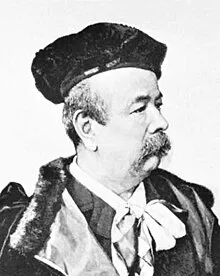How London Lost Fashion
Published January 1, 2025
London was the epicenter of fashion nearly all of history. In one century, Paris usurped the title. How did this come to be, and what lessons can America apply today?
Folks from New York, Milan, and London might have half-hearted protests, but the reality is that Paris is the undisputed fashion capital of the world. From its storied history (Balenciaga, Coco Chanel, Dior, Louis Vuitton) to its long-standing traditions that still dominate the fashion world today, like the Paris fashion week. Even COVID didn’t do much to change Paris’s grip on fashion.

But how did it come to be? Up until the twentieth century, only the rich dressed well (and only some of the rich did so fashionably). It wasn’t until wealthy men in the Americas started to order clothes from London tailors that the fashion ‘industry’ even began. In the 1790s, Beau Brummell standardized men’s fashion and became the de facto judge of what was allowed in Regency England, which ultimately became the standard internationally. And, for a while, London would remain the epicenter of men’s fashion.

Paris’ dominance in fashion is rooted in women’s fashion, and it all began with an Englishman by the name of Charles Frederick Worth. He made the rather contrarian choice to set up shop in France of all places.
Britain was the world center of the textile trade (except for silk) and was the first country to establish large department stores, so it is curious that Worth, who was enormously inventive, methodical, and businesslike, did not choose to make London the center of high fashion.
As in most things, it came down to government. Queen Victoria was a good, God-fearing woman and even prior to her widowing, she was certainly not interested in dresses or fashion. The aristocratic women of England, taking her cues as unspoken law, soon followed.
Empress Eugene, on the other hand, was very passionate. It’s not clear who did the begging, but by 1860 Worth was appointed as her official dressmaker. It was not an appointment without merit: he was exceedingly innovative. Almost everything we take for granted in modern fashion was invented by Worth:
[F]or the first time, he began to make for her entire multi-dress outfits, one set in January for the spring and summer, and another in July for the autumn and winter. This determined the cycle of the Parisian dress year; and since the empress rarely if ever wore the same dress twice, and certainly never wore a dress from the year before (and since all the Parisian rich followed her example), Worth greatly expanded the volume of what he called haute couture. The system demanded seasonal change to make clothes from the previous season look out of date and therefore unwearable. Worth responded with astonishing ingenuity and ruthlessness. He invented “planned obsolescence” a century before the term was coined. Among his novelties were: the antique over-tunic (1860); the shorter, ankle-clearing walking skirt (1862–1863); the flat-fronted cage (1864); light-colored spotted and striped summer dresses (1865); and fur trimmings (1867). In 1868 he abolished cages completely and with them the long-lived crinoline — a dramatic step that achieved the first real coup in fashion history. In 1869 he brought back the bustle, another audacious step that paid off.
After Worth, his son, Gaston, took up his father’s mantle and continued to make France the capital of women’s fashion (and soon, all of fashion). Gaston was arguably more important than his father, because it was the son who established the close links between Paris and the rest of the textile trade (Lyon’s silk makers for example). By 1910, Gaston had Paris firmly cemented as the global capital of fashion (over 110 fashion houses at the peak of Parisian history).
There is, however, an interesting historical point, which is not sufficiently grasped by those who study fashion. There was no intrinsic reason why women’s high fashion should be centered in Paris rather than London. Paris became the center essentially because Empress Eugénie provided client-leadership and Worth responded with designer leadership. If Victoria had died in, say, 1870, and Alexandra, an unusually handsome woman with a fine figure, had become queen and offered client leadership, Worth would have responded by transferring his house to Mayfair, and the whole story would have been different. Design was, and is, international, and a good dressmaker can operate anywhere if the market is encouraging.
Even the dressmakers of Paris at the time recognized that their industry had essentially been handed to them on a silver platter by England’s poor policies.
In 1938 King George VI and Queen Elizabeth visited Paris, and the dressmaking industry there celebrated the fact that England had a jolly and delightful but dowdy queen, no threat to their interests, by giving the two princesses, Elizabeth and Margaret Rose, a collection of dolls with a 300-piece wardrobe.
What started out initially as simple brain drain soon morphed into a talent magnet. Forgotten by many today, Parisian fashion has been shaped as much by foreigners as by native Frenchmen. Another Englishman, John Redfern, was the first to create lighterweight and sports clothes for women as early as the 1870s. Captain Molyneaux (yet another Englishman), Mainbocher (American), Elsa Schiaparelli (Italian), and so many more. But one name looms larger than all the rest: Balenciaga.
Among the foreign-born masters of Parisian fashion, Balenciaga was the greatest. Indeed many would rate him the most original and creative couturier in history. And he was a true couturier, not just a designer: that is, he could design, cut, sew, fit, and finish, and some of his finest dresses were entirely his own work.
The modern state of Balenciaga’s brand is a shadow of its former self, but at his peak, Balenciaga was the preeminent designer in the world. He inspired Dior, Chanel, and many of the French houses to far greater heights. Just look at how Dior (himself one of the greats) speaks of and to Balenciaga:
He always called Balenciaga maître. In December 1948, Balenciaga’s partner, Vladzio, died at age forty-nine. The master was so upset that he seriously considered retiring and returning to Spain. The word got around, and Dior went to see him on Avenue George V and begged him to stay: “We need your example in all that is best in our trade.”
All that is best indeed, for he was the only one who could sew, cut, and make a dress by himself in full, a fact which “was true of virtually all the others, then and since.” He was the only true couturier, and the rest were just designers. So it came to be that the greatest of Parisian high fashion was not, in fact, French.
Unlike the English, the Germans were much wiser to the French supremacy in fashion. When Paris was lost in World War 2, there was an explicit goal of relocating design talent back to Berlin.
The Germans were jealous of the French fashion industry, and both Hitler and Goebbels believed that under the Nazis’ “new order” for Europe, Berlin would usurp the role of Paris as the world center of fashion (and of art generally). When the Nazis seized Paris, German agents ransacked the offices of the Chambre Syndicale de la Haute Couture and carried off all its archives to Berlin. The idea was to recruit all the top cutters, sewers, and designers as forced labor and set up dress houses in Berlin.
Indentured servitude of clothing designers is like a gardener screaming at plants to grow faster and wondering why they don’t. While this may be the stupidest plan I have ever heard of, ignorant in every manner to the creative process, at least the Nazis recognized the importance of vital talent, unlike the Brits who seemed to just give up their supremacy unknowingly.
There’s been a great hubub all over the internet about H-1Bs and the various policy proposals to address problems. I’m not claiming in any way that the current system is perfect, but it has become increasingly clear to me that we’re on the brink of a watershed moment for the global tech sector.
Software, like design, is international and a good software engineer can operate from anywhere in the world, if the market is encouraging. The United States is currently the de facto software capital of the world. The current market is encouraging, and we have all the connections needed from VCs to bankers to favorable laws.
Whatever solution we come up with, let’s not make an unforced error by giving up the greatest golden goose the world has ever seen. If we don’t allow talented people to come here, they will certainly go elsewhere, and we will only have ourselves to blame.
All these quotations and facts are found in the book Creators by Paul Johnson.